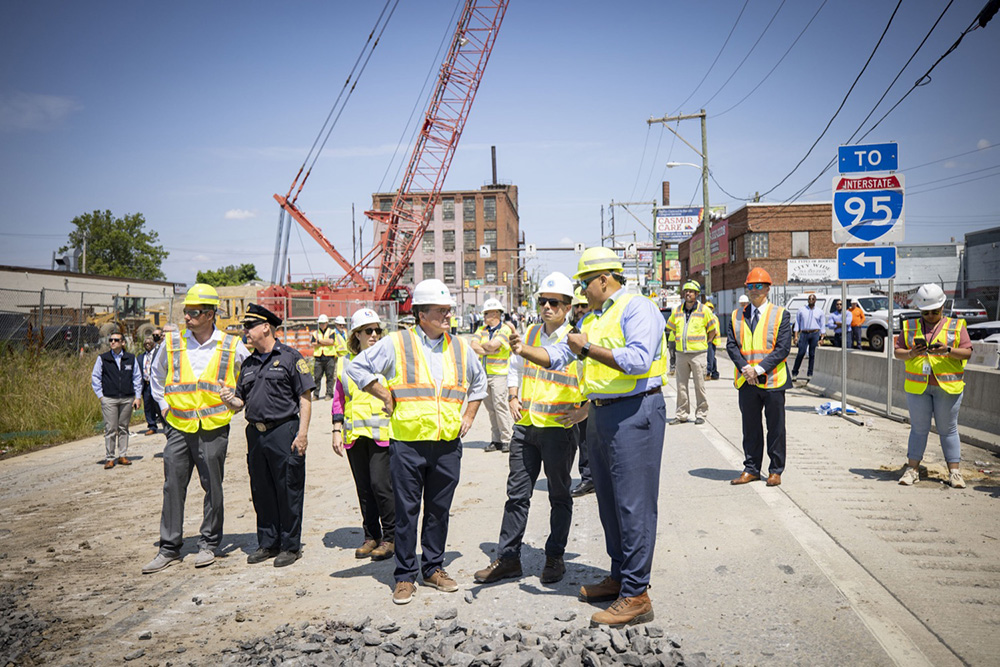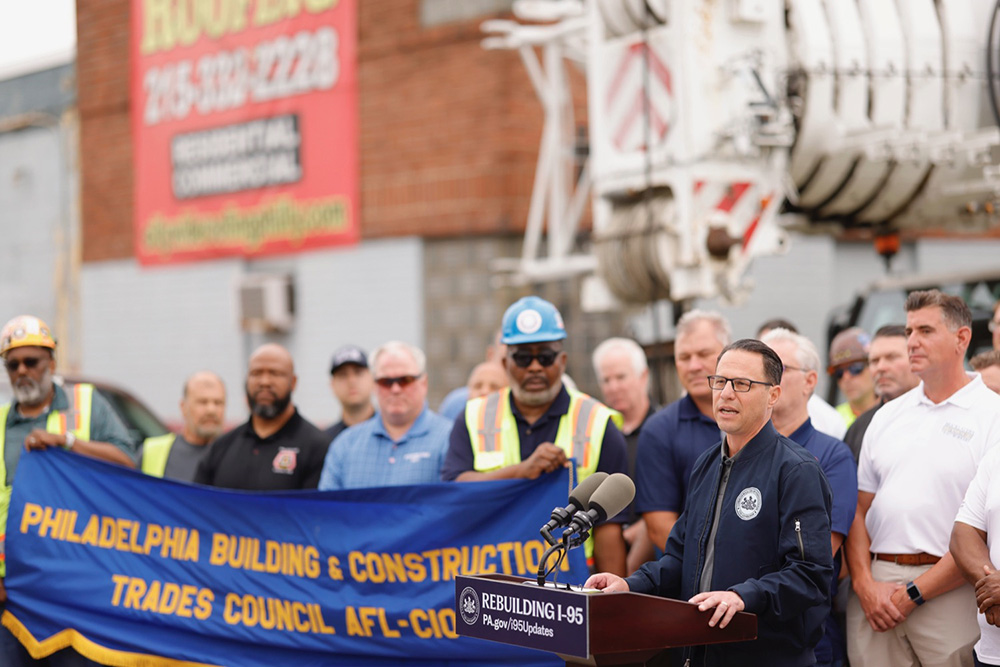
Interstate highways are the arteries of the US transport system. So, when one is suddenly put out of action, the effect is similar to an embolism: a major problem and possible lasting harm.
So why wasn’t that the case after a fuel tanker carrying 8,500 gallons of petrol crashed on an off-ramp in north-east Philadelphia under I-95, the main interstate highway running down the eastern seaboard of the US?
The incident on Sunday 11 June caused a blaze so intense that it weakened the steel supports of the elevated northbound section of the interstate above it, causing it to collapse. The adjacent southern carriageway had also to be demolished after it was determined that its structure had been compromised.
Immediate aftermath
In the immediate aftermath of the accident, Governor Josh Shapiro of Pennsylvania predicted that restoring the eight-lane highway would take “some number of months”. Yet it was up and running again – albeit with six temporary lanes – in 12 days.
Travel chaos was widely predicted, as the section typically carries around 160,000 vehicles a day. Yet that chaos never occurred. Why?
Firstly, people were made aware of the problem swiftly: “This made national news – a section of one of the major corridors in the US,” said transportation analyst Bob Pishue at traffic data specialist Inrix.
The resulting publicity meant that, come the Monday morning after the crash, most people who may normally have used that stretch of I-95 were aware of the problem and avoided it, easing congestion.
Pennsylvania DoT (PennDoT) implemented primary detour routes and signage immediately and, together with local, state, and federal partners, instantly put out public messaging on the detours.
PennDoT has produced software that relies on crowdsourced incident data from Waze and Inrix, two transportation mobile applications that provide traffic speed and incident data.

Real-time information
The technology pulls together the speeds and incidents from a subset of vehicles on a given segment of roadway to provide real-time information, enabling PennDoT to create travel-time messaging and increase roadway situational awareness.
This allows PennDoT to quickly and more accurately display this information on the public-facing 511PA traveller information website and it published an I-95 incident page on the site, displaying average, real-time travel times for the incident detours.
Other factors that reduced normal traffic flows were telecommuting, which has become more common post-pandemic, so at least some commuters were able to revert to that mode of working. Commuters also started to consolidate their journeys, rather than making a series of unlinked trips. Additionally, the advent of online shopping cut down ”a bunch of trips” that some people would otherwise have made, Pishue said.
“I think people were making all these individual decisions,” he added. “There was some congestion and increased travel times in the region, but it wasn’t dragging on.”
A major factor behind the relative lack of congestion was the creation of several diversions, notably along US Route 1 (US1) and US13, which both run approximately parallel to I-95. Although these two routes are relatively distant – US1 is around 30 miles to the west, while US13 lies approximately 40 miles east – they allowed long-haul north-south traffic to continue flowing while avoiding the affected city centre route.
Traffic flow
Average road speeds dropped – in some cases considerably, from 30mph to 20mph – but traffic largely kept flowing. “Traffic did build up and travel times did increase by various amounts, depending on what road you were on or what detour,” said a PennDoT spokesperson. “But it wasn’t gridlock for the entire region. People made changes to their travel plans.”
Within a day of the collapse, Southeastern Pennsylvania Transport Authority (Septa), the transit provider for Philadelphia and the four surrounding counties, had put in place changes to its rail services, notably the Trenton, West Trenton, Warminster and Fox Chase Regional Rail Lines, by adding carriages to scheduled peak service trains.
Additional morning and afternoon rush-hour services were also loaded into the timetable. Septa reported that ridership increased by about 14% on the three lines serving the affected area. It negotiated increased staffing hours with unions to help cope with the influx of additional passengers. And to encourage commuters to let the train take the strain, Philadelphia Parking Authority made parking free at Regional Rail stations.
Septa CEO Leslie Richards noted that pre-incident ridership was still below pre-Covid levels, which gave the system some slack to cope with drivers switching from their cars. Additionally, Septa pushed the option of the city’s existing Share-A-Ride computerised service that matches commuters who work in south-eastern Pennsylvania with transit services, potential carpool and vanpool groups.
Incident response
Other practices that PennDoT has introduced in recent years to support and improve traffic control at incidents more generally include expansion of the incident response traffic control role of transportation department freeway services patrols; implementation of active traffic management techniques, such as remote signal-timing adjustments, and alternate route planning; pre-signing or pre-staging traffic control devices; use of mobile command centres; focused planning, coordination, and cooperative efforts among responding agencies; and ongoing training for all responders.
“Traffic management has gotten easier with new technology,” noted Pishue. “PennDoT and everyone got all the information out using all their channels.” These allowed drivers and freight hauliers “to get up-to-date information and adjust on the fly; that wasn’t possible 10 to 20 years ago”.
15 June saw the conclusion of the demolition stage of the I-95 renewal, several days faster than originally planned. Construction of the replacement roadway began the following day, with a base of foamed glass aggregate being laid on the roadway to serve as the foundation as construction crews began to fill in the gap up to the surface level of I-95.
As construction progressed, a live feed of the work became one of the most popular streaming services in the city and surrounding area.
One reason behind the swift restoration of the road link was that it was recognised immediately that it was an “all hands on deck” event that brought together the state DoT, employers, transit authorities and agencies, such as the Metropolitan Planning Organization.

Highways upkeep
Mike Carroll, Pennsylvania’s secretary of transportation, said that, by chance, a specialist roads contractor was already working nearby on another project on the interstate and the equipment it had to hand was exactly the type of kit required for the reconstruction process.
The contractor making the repair was chosen on a no-bid contract basis, rather than having to go through the normal lengthy bidding and evaluation process.
One other factor that helped have the affected section of road repaired swiftly was that it had been built only around a decade ago. This meant that many of the plans were available in digital form and could be swiftly called up, consulted and used as the basis for rebuilding the missing structure.
“The ability to roll in a structure within two to three weeks is something we can do now,” noted Pishue, with prefabricating structures off-site becoming the norm. “It’s happened a few times now. It’s becoming incorporated into the playbook.”
According to PennDoT: “I-95 has been a masterclass in emergency management, public messaging, and the miracles of 2,000 tons of recycled foamed glass aggregate. One lesson learned is to have greater trust in new technologies that can be more durable, less expensive and quicker to assemble. Lightweight aggregate materials are just one example of how you can implement new technology and at the same time be green and sustainable.”
Another lesson, said Pishue, is a new focus on the relative lack of redundancy in the Interstate network. “When a piece of it goes down, it affects the whole area,” he said. “You don’t want to build highways just for redundancy, but I think it shows a little bit of fragility in the system.” Although this collapse did not result from a lack of maintenance, it may lead to a greater focus on highways upkeep, to minimise such problems in future, he suggested.
Also significant was the declaration of a state of emergency around the incident. That freed up federal funds that cut out the normal budgetary bureaucracy required for a major project such as this.
“Governor Shapiro’s state emergency declaration for Philadelphia cleared the way for decisions and construction that can take months, if not years, for conventionally-planned projects,” noted PennDoT. “The need for speed, getting money, materials, equipment, and people to work around the clock, doesn’t factor into the vast majority of American highway construction projects.”
“I think one thing we learned is that we can build fast when needed,” Pishue concluded.





